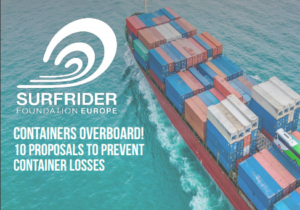Surfrider Foundation Europe published a report discussing container loss and its impact in the marine environment. In the meantime, the Association recommends ten measures to regulate a proportion of container traffic, thereby cutting the number of annual container losses.
Specifically, Surfrider Association, is not-for-profit association, under the French 1901 law, whose mission is ‘defending, saving, promoting and sustainably managing the ocean, coastline, waves, and the people who enjoy them.’
According to the report, container traffic holds the 80% of the flow of goods transported by sea.
Loss of containers is a phenomenon that has fatal impact not only to the shipping industry and its stakeholders, but also to the marine environment. The loss of containers from ships can arise from incidents at sea, accidents or from major safety failures.
Meanwhile and in light of the above, the World Shipping Council informed that the most usual factors that cause a vessel to sink, are:
- Packing issues;
- Overweight containers;
- Inadequate planning;
- Poor lashing performance;
- Fully automatic twistlocks (FATs);
- Voyage planning/navigation.
Up to now, it is still impossible to accurately measure the scale of these losses. Countries have no common international method to monitor container losses, which constitutes an obstacle to the inter-operability of fragmented databases worldwide. This applies to measurements (TEU and container numbers) as well as data-gathering procedures.
In the meantime, container losses are thought of as important as oil discharges or other pollution incidents, but still they represent a highly diverse source of pollution that doesn’t fit into any adequate regulatory framework. Yet, container losses have a serious impact on the environment; For example, when the ‘Maersk Shanghai’ container vessel sank in 2018, many containers were sank and lost at sea. A year later, BBC highlighted that Nike training shoes are being washed up on beaches, from Bermuda and the Bahamas to Ireland and Orkney.
According to the report, amongst the products lost are most commonly:
- food products and their packaging
- toys
- footwear
- medical supplies (drips, bottles)
- vehicles
- inflammable and hazardous substances (sulphuric and nitric acid)
- explosive or radioactive substances
- billions of plastic pellets.
Despite these cases, pollution from container losses is still difficult to measure. To date, we can estimate the effects of container losses in terms of pollution, but given the lack of data on losses and loads, it is difficult to conduct impact studies on their contents. Overall European and international standards must be urgently adopted to prevent and report losses
The Association proposes ten measures to regulate a proportion of container traffic, thereby cutting the number of annual container losses.
- Ensure and police “ship planning” vessel compliance;
- Ensure proper transparency on container losses;
- Clarify the legal status of lost containers and related liabilities;
- Facilitate container traceability and visibility to boost their recovery;
- Make several safety measures mandatory:
- The phasing out of sub-standard cargos
- Give consideration to limiting deck-loaded cargo transport
- Introduce a tolerance limit on container weight declarations
- Adopting high standards for container quality and stowage systems
- Promote unannounced inspections and checks on proper stowage measures and container condition
For more information, you may click on the PDF herebelow





























































